Name: Ele Willoughby
Websites
Etsy: http://minouette.etsy.com
Blog: http://minouette.livejournal.com/
Flickr: http://www.flickr.com/photos/22611996@N02/
Recent Exhibition: "Toronto vs. Nagoya Art Fight" at the CREATORS MARKET in Nagoya, Japan, June 14 to 15, 2008.
How did you get started in printmaking?
I'm actually a physicist by training. My 'day job' is as a research associate in marine geophysics - which means I build instruments, go to sea, gather data, analyze and make computer models of the results, to try to learn what is below the seafloor. I've always loved art and art history on the one hand, and math and physics on the other. I decided that I could not pursue the physics on my own, whereas the art did not necessarily require a PhD.
I got started printmaking as a child. I had the good fortune to attend courses at the Art Gallery of Ontario, here in Toronto, from the age of about 8 or 9 (I am currently 34). I learned screen-printing, etching, lino printing and some more exotic methods for mono prints, embossing, etc. I have prints I made 25 years ago! The great thing about starting at such an age is that things like registration, or never ever carving towards oneself becomes quite intuitive.
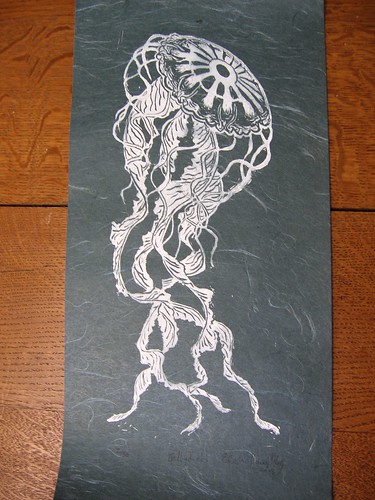 Also, we regularly viewed their collections and shows. We had access to great resources that otherwise I would not have had. It is hard to believe they let children operate the press, or more to the point, use knives and carving tools, but they did (though we were not allowed near acid baths). I pursued classes there for ten years, and always took art classes in school.
Also, we regularly viewed their collections and shows. We had access to great resources that otherwise I would not have had. It is hard to believe they let children operate the press, or more to the point, use knives and carving tools, but they did (though we were not allowed near acid baths). I pursued classes there for ten years, and always took art classes in school.While pursuing a doctorate in physics, I had less time to study art, but did screen printing on my own time. I found all the left-brained work for my job, left me craving the balance of art making for the right-brain. I would take courses in my spare time, in things like bronze sculpture or hand paper-making (which influences my choices for papers). In the last 5 years, I really started to focus on relief printing. Linocuts were something I could make in my own home, and I could choose to use strictly water-based inks, and avoid any potentially more harmful chemicals. I went to "Woodblock Printing Boot Camp" to learn Japanese moku hanga techniques (and they weren't kidding about the Boot Camp). I've imported what I learned and applied it to my lino work.
Wow, your career seems very interesting and challenging. Do you find that your imagery is influenced by your day job?
Yes, mainly in that I like to portray animals (amongst other things), and observing ocean life is a fringe benefit of doing fieldwork at sea. Also, my first woodblock print is really a metaphorical depiction of how it feels to do my job. I
 spend months building equipment (from the electronics, to the large deployment packages weighing hundreds of pounds) and lower them to the seafloor, hoping they'll come back safely, and do what they were intended to do. They spend hours, in maybe 1.2 kilometer (~3/4 of a mile) water depth... far from me on the surface. What I've really learned is that I am not in charge; the ocean is in charge. Sometimes things are lost, or there are gale force winds, or something corrodes, and it is not your fault and there is nothing you can do. I must never underestimate the ocean.
spend months building equipment (from the electronics, to the large deployment packages weighing hundreds of pounds) and lower them to the seafloor, hoping they'll come back safely, and do what they were intended to do. They spend hours, in maybe 1.2 kilometer (~3/4 of a mile) water depth... far from me on the surface. What I've really learned is that I am not in charge; the ocean is in charge. Sometimes things are lost, or there are gale force winds, or something corrodes, and it is not your fault and there is nothing you can do. I must never underestimate the ocean.For the record, I've never seen any giant octopi, though I have see squids having a feeding frenzy, bioluminescent invertebrates, large sharks, many birds, lot of whales (especially orcas, humpbacks, right whales), porpoises, dolphins and other creatures at sea.
Where do you do most of your printing?
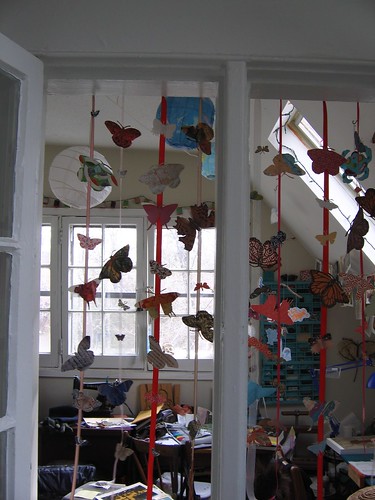 I do most of my printing in my home. I have, what I affectionately call, 'the microstudio'. Our apartment is on the third floor and the roof is slanted. The microstudio was once the porch, but is now closed in. I have a few tables as work surfaces, some storage for supplies, a bookshelf (for inspiration and information), a solid chair for when I'm carving. I have hung lines on the slanted ceiling with mainly postcards of art for inspiration- this doubles as drying rack for prints. I have quietly encroached onto the living room, with a large shelving unit hidden in a corner- this contains my paper, prints, shipping and packing material.
I do most of my printing in my home. I have, what I affectionately call, 'the microstudio'. Our apartment is on the third floor and the roof is slanted. The microstudio was once the porch, but is now closed in. I have a few tables as work surfaces, some storage for supplies, a bookshelf (for inspiration and information), a solid chair for when I'm carving. I have hung lines on the slanted ceiling with mainly postcards of art for inspiration- this doubles as drying rack for prints. I have quietly encroached onto the living room, with a large shelving unit hidden in a corner- this contains my paper, prints, shipping and packing material.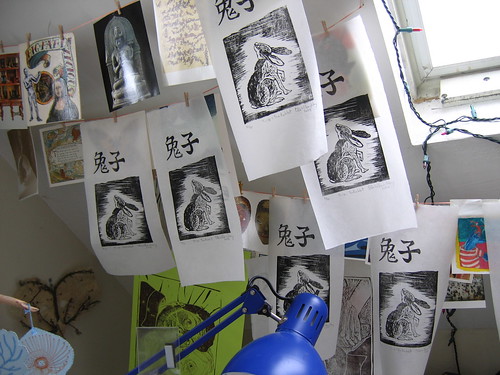
What is your creative process?
I'm usually up to something- things come in series. Currently, I'm completely a series of 12 Chinese Zodiac prints. I'm also printing panels on fabric for an alphabet quilt, as a personal project- so there are prints which are a by-product of this process. Generally, I print things from nature (mainly animals) or myth (which often includes composite creatures, which are at least part animal). I tend to look at a lot of images to gain an understanding of anatomy or structure (these can include photos or other artworks) and a sense of how an animal typically moves (which is both anatomy and 'personality').
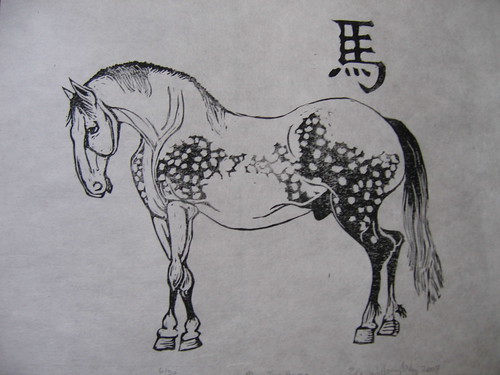 For the Chinese Zodiac prints, I'm also learning the associated Chinese characters, and looking at a lot of Asian art, to try and reflect that influence. For instance, I selected to make the horse a little rotund as that is how they are generally depicted in Chinese art. I mull these images over for a while and then draw. Sometimes I sketch (particularly if I need to work out the balance and composition), but sometimes I draw directly onto the lino. Often they evolve as I carve and make sporadic proofs, so the end product is not exactly as imagined or drawn.
For the Chinese Zodiac prints, I'm also learning the associated Chinese characters, and looking at a lot of Asian art, to try and reflect that influence. For instance, I selected to make the horse a little rotund as that is how they are generally depicted in Chinese art. I mull these images over for a while and then draw. Sometimes I sketch (particularly if I need to work out the balance and composition), but sometimes I draw directly onto the lino. Often they evolve as I carve and make sporadic proofs, so the end product is not exactly as imagined or drawn.What inspires you?
Nature, particularly animals (extant and extinct), myth, legend, fairy tales, the unexpected, literature, science. Colour! Illustration. I like to play with scale and achieve a gentle surrealism simply by changing relative proportions. I love to travel (basically anywhere not immediately dangerous) and this includes going to sea.I love art history- all of it. Favorite artists include great printmakers like Albrect Dürer, Goya, Rembrandt, Honoré Daumier, Joan Miró, Odilon Redon, M.C. Escher, Japanese masters like Hiroshige, Hokusai, and ukiyo-e in general. As well as a near endless list of painters sculptors, and artisans. (Those mentioned are just those who made prints, off the top of my head).
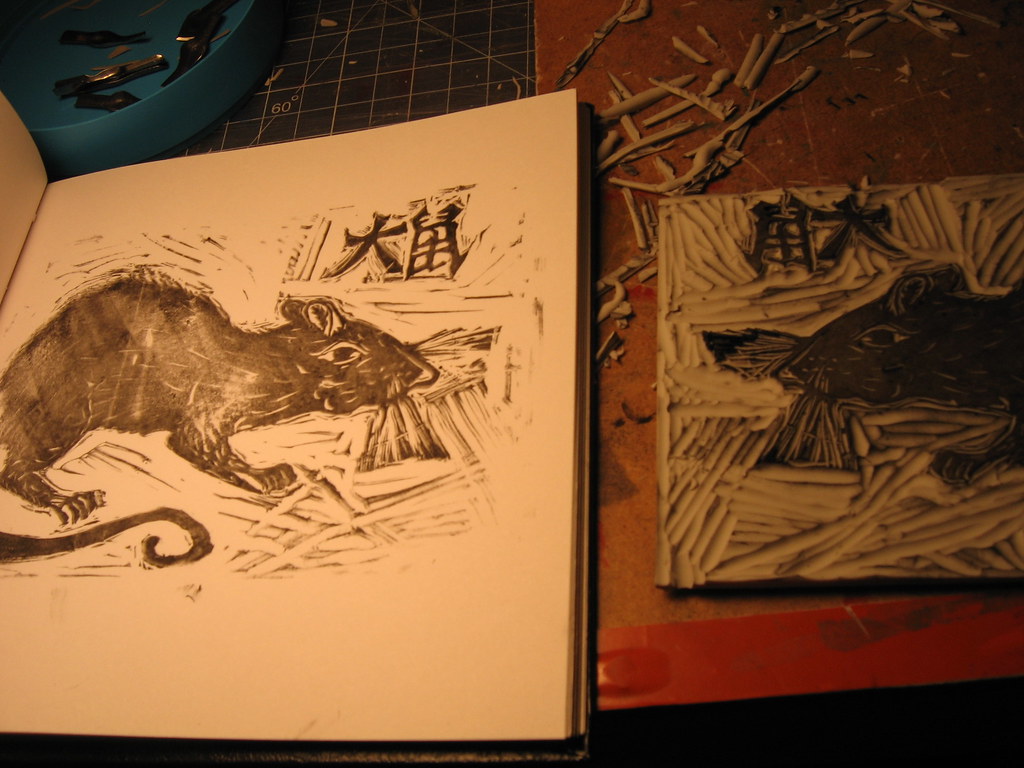 What do you enjoy most about printmaking?
What do you enjoy most about printmaking?The way creating a print is a process and allowing the thing to change as I work. I love the carving, and (obviously) that I get multiples, which is kind of magic.
What is your least favorite part of the process?
Physically burnishing a print, and when something goes wrong.
How has your work changed and evolved since you first started?
Well, I can spell my titles correctly now! ;) Since I started so young, there are some things which have obviously changed a lot (I worked more with geometrics and patterns as a child, and my compositions are now much simpler, often a single animal in a blank field). But some things are surprisingly constant, in hindsight. Most recently, I'm conscious of how I choose to work with a single block, avoid reduction prints, use my moku hanga bamboo-leaf-tied barren even for lino, and work on Japanese washi paper (especially kozo, or mulberry). These are new habits for me.
How do you get past creative slumps?
This really isn't a problem for me, possibly because art remains a passion without being my 'job'. I do have creative slumps as a geophysicist! These generally lead to self-proscribed art therapy. But even if I am unhappy, I have boundless ideas for things to create. I can't keep up with my plans for art.
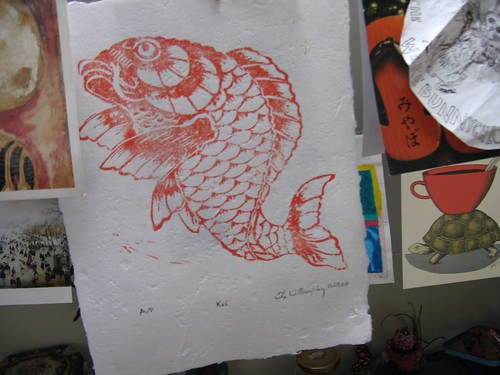 How do you promote your work?
How do you promote your work?Well, I haven't been selling the art for very long. But, I make sure to share it with people (on my blog, on craftster.org, on flickr, on etsy), to network (street teams are wonderful for this), and to take opportunities when I see them.
With all of your experience, do you have any advice or comments for others who may want to try printmaking for the first time?
Every teacher has something different to offer. There is no right way. Gather the information you can from any means available and get in there and try it. As an experimentalist and as artist, I believe in learning through doing.
But do take responsibility for your own health- be aware of safety (especially with knives, carving tools, chemicals, inks, solvents and cleaning products). Do not be intimidated and know that you can request a Material Safety Data Sheets (MSDS) from manufacturers. If in doubt ask. It is possible, but not necessary to place yourself at risk for art.
Thanks Ele, it was a pleasure getting to know you and your work!
3 comments:
Wow, another scientist printmaker! Great to learn more about you, Ele. Is that Graham Scholes' moku hanga bootcamp you attended? I'm sure you got a good education there! I took a look at your blog and loved seeing your prints on fabric, too.
Hi Annie,
Yes it was Graham Scholes' moku hanga bootcamp! I did learn a lot there (and built up those arm muscles too).
Thanks very much!
Ele
Thanks to Leanne for writing the interview! I enjoyed the discussion.
Thanks to Amie for help with the photos and html.
Thanks Ele! So nice to learn more about you and your process!
Amie pulled it all together with the photos and links - great job!
( Note - Amie found the photo of the giant octopi on your flickr!)
Post a Comment